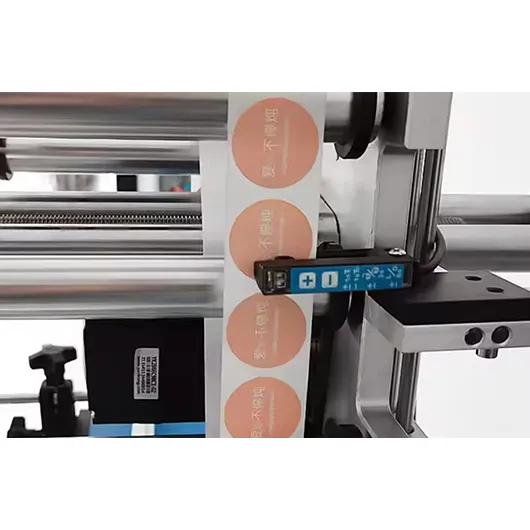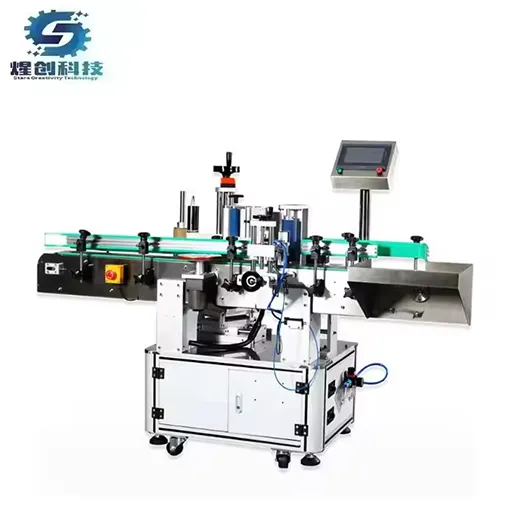Avoid your inquiry is delay response, please enter your WhatsApp/Skype along with the message, so we can contact you at the very first time.
We will reply you within 24 hours. If for urgent case, please add WhatsApp/WeChat: ,. Or call directly.
The principle of a sticker labeling machine is to automate the process of applying adhesive labels (stickers) to products or packaging. These machines play a pivotal role in industries such as food and beverage, cosmetics, pharmaceuticals, and consumer goods, where high speed and accuracy are essential.
Sticker labeling machines work by feeding labels onto products in a controlled manner, ensuring precise application without the need for manual labor.

The machine uses advanced technology to ensure high-speed, consistent labeling, and is ideal for both small-scale and high-volume production. In this article, we will explore the principles behind labeling machines, how sticker machines work, the types of machines available, and a comparison between automatic and semi-automatic systems.
The basic principle of a labeling machine revolves around automating the process of attaching labels onto products or packaging. This is achieved using a combination of mechanical systems such as conveyors, motors, and sensors, which help dispense, align, and apply labels with high accuracy.
Labeling machines work by feeding labels from a roll, applying them onto the product, and ensuring precise placement at high speeds.

Labeling machines are designed to provide a consistent and reliable method of labeling products. Here’s how they work in more detail:
The process begins with the label roll. The machine unwinds the roll of labels using a motorized system. This dispensing mechanism ensures that each label is separated from the roll without sticking to the adjacent label. The labels are fed into the system, which will control the movement of the label to the exact point of application.
Once dispensed, the label must be aligned to the product. Depending on the type of machine, sensors or mechanical guides help position the product and label accurately. In high-speed systems, the product often moves along a conveyor belt while the labeling machine applies the label without stopping.
The labeling head applies the label to the product using controlled pressure from rollers or similar mechanisms. For bottles and cylindrical objects, this might involve rotating the product while applying the label. The pressure ensures that the label sticks securely to the surface, preventing peeling or shifting.
Some advanced labeling machines are equipped with inspection systems. Cameras or sensors detect any misalignments or errors in the labeling process. If a mistake is found, the machine will either reject the product or notify the operator for correction.
Many labeling machines are designed for high-speed operations and are adjustable to accommodate different product sizes and label dimensions. This ensures that the machine can handle a variety of packaging types and still maintain precision and efficiency.
Labeling is a critical step in product presentation, brand identification, and compliance with regulatory standards. Automatic labeling machines significantly reduce human error, increase efficiency, and maintain consistency across large batches of products.
A sticker labeling machine operates by automating the process of applying adhesive labels to products. The machine typically consists of a label roll holder, a dispensing mechanism, a conveyor system, and a labeling head.
The machine feeds the label from the roll, positions it on the product, and adheres it to the surface using controlled pressure.
Understanding how a sticker labeling machine operates is important for selecting the right system for your needs. Below is a detailed explanation of the machine’s working process:
A roll of adhesive labels is loaded onto the machine. The machine’s motorized system unwinds the roll at a steady pace, ensuring smooth dispensing. Depending on the design, the machine may use rollers or friction feeders to ensure that only one label is dispensed at a time.
Once the label is unwound, a mechanical or pneumatic separation system ensures that each label is separated without any overlap. This step is critical to avoid feeding multiple labels at once, which could lead to misapplications.
After the label is separated, the product is aligned using a conveyor belt. Sensors and guides ensure that the label is positioned accurately on the product. This step is especially important for irregularly shaped products, where precise placement is crucial.
The labeling head applies the label to the product with a controlled pressure. Depending on the type of product, the machine might use a rotating mechanism to apply the label evenly, especially on cylindrical or bottle-shaped items.
Sticker labeling machines are designed to accommodate a range of product sizes and label dimensions. They can be adjusted for different speeds, which is crucial for high-volume production. This adjustability ensures that manufacturers can meet the demands of their production lines.
Some advanced machines are equipped with cameras or sensors that check the label’s position, ensuring it’s applied correctly. If there’s a mistake, the machine might automatically reject the product or alert the operator.
There are several types of labeling machines available, each designed for different applications and product shapes. The choice of machine depends on the type of label, the size of the product, and the speed required.
Common types of labeling machines include wrap-around, top labeling, front-and-back, and print-and-apply machines.

Here’s a breakdown of the different types of labeling machines:
| Labeling Machine Type | Description | Ideal Use Case |
|---|---|---|
| Wrap-Around Labeling3 | Applies labels that wrap around cylindrical products. | Bottles, cans, jars, and other round products. |
| Top Labeling | Labels the top surface of products or packaging. | Boxes, trays, or cartons. |
| Front-and-Back Labeling | Applies labels to both the front and back of a product. | Flat packaging like sachets and bags. |
| Print-and-Apply | Prints and applies labels on-demand, such as barcodes. | For batch numbers, dates, and custom labeling. |
Selecting the appropriate labeling machine can improve efficiency and reduce production costs. Choosing the right machine depends on your specific packaging needs, such as the shape and size of the products and the speed required for production.
The choice between automatic and semi-automatic labeling machines often comes down to budget and production volume. While automatic machines offer high-speed labeling with minimal human involvement, semi-automatic machines are more affordable and better suited for lower volumes.
Automatic labeling machines are typically more expensive but offer greater efficiency and precision for large-scale production. Semi-automatic machines are more cost-effective but require more human input.
Automatic labeling machines are fully automated, requiring minimal human intervention. These machines are best suited for high-volume production environments and offer faster speeds and greater precision. While they require a higher initial investment, they save time and reduce labor costs in the long run.
Semi-automatic machines require more manual labor. The operator is responsible for tasks like feeding products into the machine and adjusting settings for label size. These machines are more affordable and suitable for smaller businesses or production runs with lower volumes.
Automatic machines have a higher upfront cost but are more cost-effective over time, as they increase production speed and minimize errors. Semi-automatic machines are cheaper initially but may require additional labor and time, which can add up over time.
If your business involves high-volume production and you want to reduce the chances of human error, an automatic labeling machine is likely the best option. However, for smaller-scale operations or businesses on a tight budget, a semi-automatic machine could be a more practical solution.
The principle of a sticker labeling machine is to streamline the labeling process through automation. Understanding how these machines work, the different types available, and the pros and cons of automatic vs. semi-automatic systems will help businesses make an informed decision. Whether you need a high-speed solution for mass production or a more cost-effective option for smaller batches, choosing the right labeling machine can improve operational efficiency and product quality.
Understanding the label dispensing mechanism is crucial for optimizing labeling efficiency and accuracy in production. ↩
Discover the importance of quality control in labeling processes to ensure product accuracy and efficiency. ↩
Learn about Wrap-Around Labeling to see how it can enhance your packaging process for cylindrical products. ↩
Understand the cost dynamics between automatic and semi-automatic machines to make an informed decision. ↩